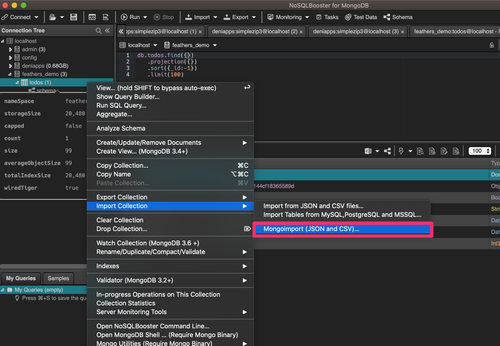All Posts In Mongodb
In this article, we will learn how to easily convert CSV files into a Restful API using FeathersJS Command Line and MongoDB. We will also learn how to cast data type using FeatherJS hook.
NoSQLBooster is probably the best free MongoDB GUI tool. We have been used to import CSV data into a MongoDB collection for a while, which works very well. But we got the error when importing JSON data. That might sound very weird, doesn't it? It ends up because we did not provide the "correct" JSON format. Let's see what JSON format to make NoSQLBooster happy.
Recently I migrated MongoDB (over 2GB) from a cheap server hosted on Hudson Valley Host to a better server hosted on Digital Ocean to improve the performance. In this article, I would like to write down some notes for this process.
If you don't want to use Stop Words in Mongodb's Fulltext search, you need to set the default language to "none" in the index. If you already created the index, you have to drop it, and then make the new one with "default language" to be "none".
By default, MongoDB has no enabled access control, so there is no default user or password. But you can only access it via Localhost. Here is my default setup after installation.
MongoDB is a popular NoSQL database that offers a variety of features to make working with data easier and more efficient. One of these features is the addToSet operation, which allows you to add a new element to an array field only if it does not already exist in the array.
MongoDB, a widely used NoSQL database, offers flexibility and scalability for various applications. However, to ensure optimal performance, it's crucial to fine-tune your MongoDB deployment. This guide addresses common warnings and provides best practices to optimize your MongoDB setup.
MongoDB’s aggregation framework made it possible to run dynamic queries and efficiently calculate these rankings, all while handling a variety of filters such as gender, age group, and event type. In this post, I'll walk through how I used MongoDB's $lookup feature within an aggregation pipeline to create these rankings.
Working with MongoDB in PHP can be confusing, especially when it comes to the behavior of findOne() and how the results can be accessed. This blog post aims to clarify the nuances and help you avoid common pitfalls.
MongoDB's find() method is a powerful way to query multiple documents in PHP. However, the way you process the results can significantly impact the efficiency and readability of your code. This blog post explores two common approaches to handling the results of find() in PHP: using toArray() and iterating directly with foreach.
This post explains why we dropped support for mongodb/mongodb 1.x in favor of ^2.0, and the challenges of supporting multiple versions in an open-source PHP library. It highlights a key limitation of Composer: even if your composer.json allows multiple versions, composer.lock can only lock one. We walk through the trade-offs, the reasoning behind our decision, and best practices for maintaining compatibility across environments.
This post explains a common MongoDB authentication mistake: using the wrong authSource in your connection string. It shows why your CLI login may work while your app fails, how to properly set authSource, whether you need the /database path in the URI, and how to avoid hidden auth errors in PHP, Node.js, or any MongoDB client.
Using { field: null } in MongoDB queries is often more efficient than { field: { $exists: false } }, because it allows the query to leverage indexes and avoid costly document fetches. We improved performance by switching from $exists: false to isWeak: null and updating the index to include isWeak, reducing query time from over 2 seconds to under 40ms. $exists is still safe in text search filters, but for most use cases, null is the better choice for speed and index optimization.
If you're using a full-text search with MongoDB and filtering out soft-deleted or duplicate records using fields like removed: { $exists: false } and dupSlug: { $exists: false }, you might wonder: should I index those fields for performance?













